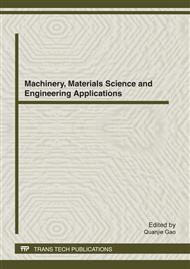p.239
p.244
p.249
p.255
p.261
p.266
p.272
p.277
p.283
The Material of the Resonant Vibration Impact Motivates the Influence of and the Simulation Analysis
Abstract:
This paper to the resonant vibration conveying material on the effect of the shock of geologic detailed analysis to research, perfect the resonant vibration against the motive of the dynamic model. Application of the method of harmonic balance system dynamics equation of solution, and draw the conclusion that, under geological body dynamics of the zoom factor amplitude frequency response curve. A test bed to the actual parameters is simulated, on the test, the displacement of the geological time response curve. The results show that: consider material impact and without considering the impact of material, compared the antiresonant frequency decreases, and in the near antiresonance point, the amplitude becomes big bodies.
Info:
Periodical:
Pages:
261-265
Citation:
Online since:
April 2012
Authors:
Price:
Сopyright:
© 2012 Trans Tech Publications Ltd. All Rights Reserved
Share:
Citation:


